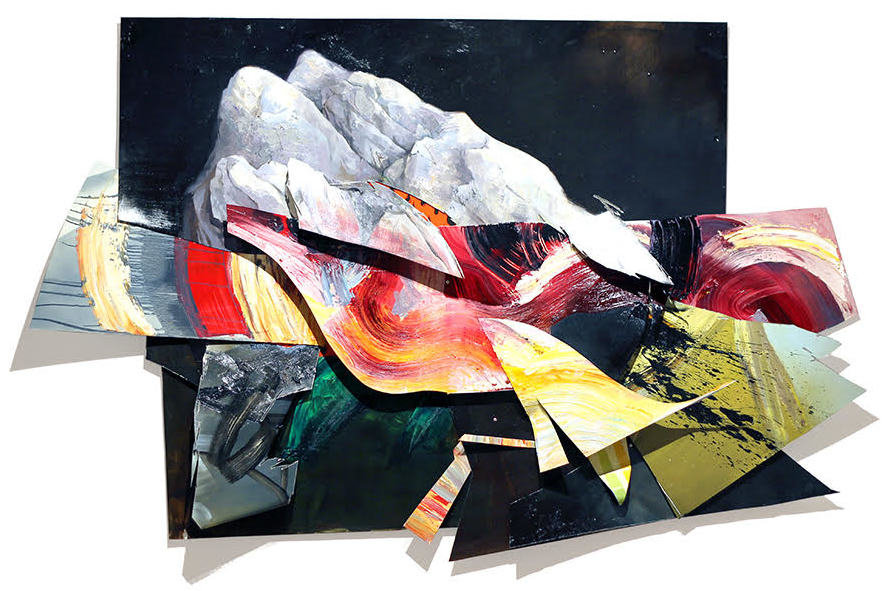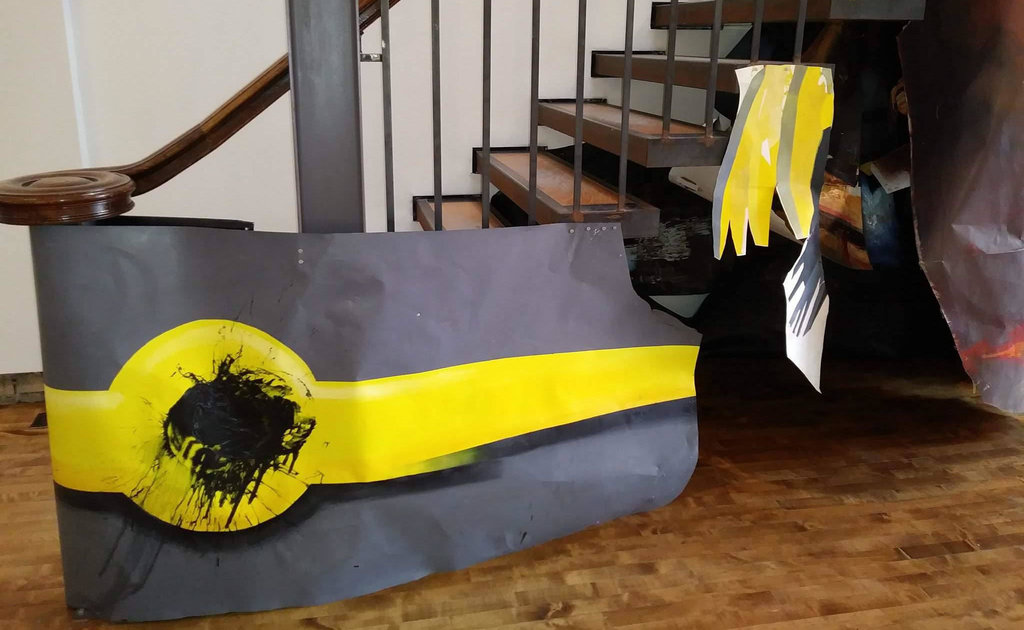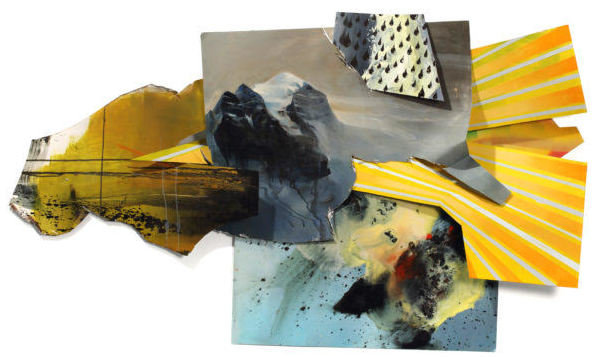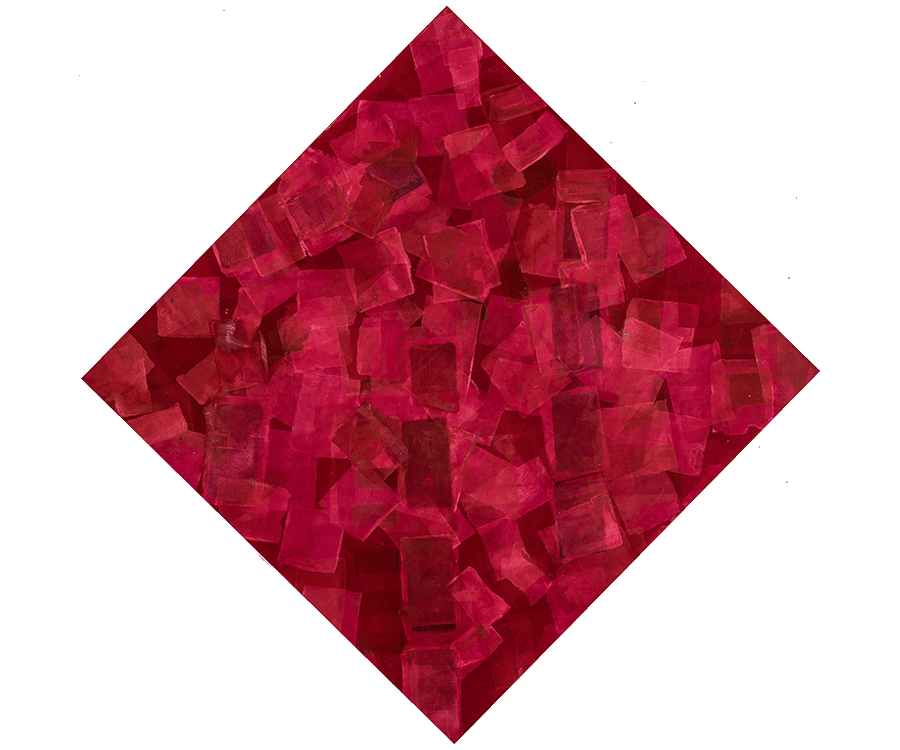A Tale of Two Exhibitions
As Phil Irish’s exhibition Peak Velocity winds down in anticipation for the solo show of fellow Ontarian artist, Pedie Wolfond, I had the pleasure of visiting the Lonsdale Gallery in that liminal gallery time when exhibitions are coming and going. The first floor of the gallery was the calm collected space of Phil Irish’s Peak Velocity – painted aluminum collages gracefully twist and coil throughout. Meanwhile, the second floor offered up a rarer sight to the gallery goer, the unwrapping of Wolfond’s new exhibition complete with the inimitable presence of the artist between folds of bubble wrap as she lovingly adjusted and assessed her latest series.
With any good narrative, it is important to return to the beginning at Peak Velocity. Pushing open the impossibly large front doors of Lonsdale, I was confronted the immensity of Irish’s unyielding paper installation blazing and engulfing the space underneath the stairs, a work that required a fuller understanding of the show before being digested. Instead, I looked to the left wall as the soft afternoon light bounced playfully onto Irish’s Fault line.
 Phil Irish, Fault Line, 2015, Oil on Aluminum, 43 x 66 inches
Phil Irish, Fault Line, 2015, Oil on Aluminum, 43 x 66 inches
Here, the traditional rectangular painting plane has been wrenched in half. The calm of the upper register belies a painterly grey mountain rising in the distance quieted by a monochromatic black background, which is eagerly disrupted as the work erupts with fire and brimstone. The artist captures the ferocity of nature as he slices the picture plane and allows the jagged edge of the aluminum to capture the harsh reality of a fault line, characteristically ushering a forth a torrent of the earth’s innards. The hot shades of red, one has to assume represent virile magma, invade the viewer’s field of vision. What unites the composition against nihilist oblivion are the waves of soft yellow light that emanate from the chaos, we become aware that black splattering of paint marks, but not corrupts the optimism of Irish’s Fault Line.
 Phil Irish, Peak Velocity Installation, 2017, Acrylic on paper
Phil Irish, Peak Velocity Installation, 2017, Acrylic on paper
The unmistakable key to this series are the hidden black “rain drops” that intermittently peak out from beneath tortured layers of aluminum. In Fault Line they fall on an orange background and are given even more prominence in the exhibition’s namesake, Peak Velocity. In 2014, Phil Irish found himself at the Banff Centre, completing an Artist residency amongst Alberta’s rugged Rocky Mountains. To the auteur, this series reflects “a need for transformation, mountain peaks meet explosive patterns of colour that reflect our hunger for speed and fossil fuelled dynamism.”
In a decidedly political manner Irish confronts Canada’s destructive dependence on Alberta’s oil sands, one if not the largest source of air pollutants in North America. This staggering statement does not take into account the inevitable oil spills and fires that plague this industry. However, Irish does not lend himself to abject cynicism, works like Peak Velocity portray the stain of this reality as the black splattering now comes to mimic oil spills and the added dark rain drops reference atmospheric pollution, yet in each compisition harmony exists with the prismic colour that Irish uses to bring both actual and metaphoric light.
 Phil Irish, Peak Velocity, 2015, Oil on aluminum, 38 x 65 x 6 inches
Phil Irish, Peak Velocity, 2015, Oil on aluminum, 38 x 65 x 6 inches
Ruminating over Irish’s conscience provoking exhibition, I drifted up the stairs welcoming a surprise meeting with the artist, Pedie Wolfond, whose solo show opens this week at the gallery. Before my introductions were made, Wolfond’s 60-year legacy in painting was expanded on by the passionate gallerist, who in hushed tones regaled me with the artist’s friendship with art history legend Clement Greenberg and her engagement with and education in the Colour Field and Abstract Expressionist movements.
Pedie Wolfond, Passio, 2017, Acrylic on raw canvas, 66 x 66 inches
However, it wasn’t the art world name dropping that struck me, but rather the nurture and passion Wolfond exuded when showing me her paintings, propped against the walls or even still in boxes. Her canvases blend the emotions of Abstract expressionism and the tactility of colour field theory. In Passio, the work moves beyond the aggression of Pollock’s action painting and the morbidity of Rothko’s stagnant pools, here Wolfond achieves a depth and richness of colour through the application of over 20 washes of oil paint, creating a mystical redness that adds an unparalled depth to her abstraction. This repetition is so intense that when showing me the canvas I almost mistook the verso for the actual composition as the oil paint, which Wolfond blends with water, had bled through demonstrating the tonality of reds, blues and greens pulsating between layers. I left the gallery excited to return and see her series when they will be mounted on the walls in all their levelled glory.
Meghan O’Callaghan
*Exhibition information: Pedie Wolfond, Solo Exhibition, Lonsdale Gallery, 410 Spadina Road, Toronto. Gallery hours: Wed–Sun 11 am – 5 pm.

